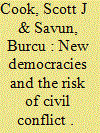|
|
|
Sort Order |
|
|
|
Items / Page
|
|
|
|
|
|
|
| Srl | Item |
| 1 |
ID:
148476


|
|
|
|
|
| Summary/Abstract |
Existing theories of regime transitions suggest that new democracies are more prone to political violence than consolidated democracies. We contend that this risk varies based on the political legacy of the new regime. Specifically, we argue that the prior authoritarian regime influences the risk of conflict in new democracies by shaping the nature of the post-transition political environment. In democracies following military rule, the former autocratic leadership often remains an active political force in the new regime. The continued presence of a materially powerful opposition creates a division in the new regime, increasing the risk of conflict by: (i) complicating efforts to consolidate democratic rule and (ii) signaling potential political opportunity to would-be rebels. In line with our argument, we find that only those new democracies emerging from military rule are more likely to experience civil conflict compared with consolidated democracies. These findings have implications for democracy promotion and conflict prevention efforts, suggesting that democratization is not always associated with an increased short-term risk of conflict as is currently assumed.
|
|
|
|
|
|
|
|
|
|
|
|
|
|
|
|
| 2 |
ID:
189135


|
|
|
|
|
| Summary/Abstract |
Police, like other bureaucratic agencies, are responsible for collecting and disseminating policy-relevant data. Nonetheless, critical data, including killings by police, often go unreported. We argue that this is due in part to the limited oversight capacity of legislative bodies to whom police are accountable. Although many local assemblies lack the means for effective oversight, well-resourced state legislatures may induce transparency from state and substate agencies. This argument is evaluated in two studies of police transparency in the United States. First, we examine the compliance of 19,095 state, county, and municipal police agencies with official data requests over five decades, finding strong positive effects of state legislative capacity on transparency. Second, we examine the accuracy of transmitted data on killings by police, finding that lethality is systematically underreported in states with lower-capacity legislatures. Collectively, our study has implications for research on policing, legislatures, agency control, and analyses of government data.
|
|
|
|
|
|
|
|
|
|
|
|
|
|
|
|
| 3 |
ID:
189122


|
|
|
|
|
| Summary/Abstract |
Time-series cross-section (TSCS) data are prevalent in political science, yet many distinct challenges presented by TSCS data remain underaddressed. We focus on how dependence in both space and time complicates estimating either spatial or temporal dependence, dynamics, and effects. Little is known about how modeling one of temporal or cross-sectional dependence well while neglecting the other affects results in TSCS analysis. We demonstrate analytically and through simulations how misspecification of either temporal or spatial dependence inflates estimates of the other dimension’s dependence and thereby induces biased estimates and tests of other covariate effects. Therefore, we recommend the spatiotemporal autoregressive distributed lag (STADL) model with distributed lags in both space and time as an effective general starting point for TSCS model specification. We illustrate with two example reanalyses and provide R code to facilitate researchers’ implementation—from automation of common spatial-weights matrices (W) through estimated spatiotemporal effects/response calculations—for their own TSCS analyses.
|
|
|
|
|
|
|
|
|
|
|
|
|
|
|
|
|
|
|
|
|